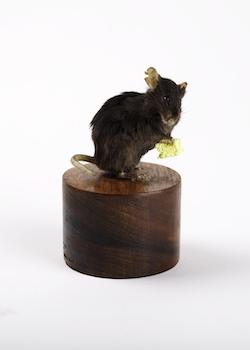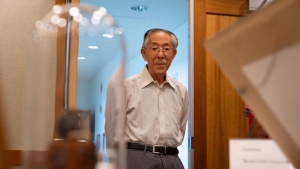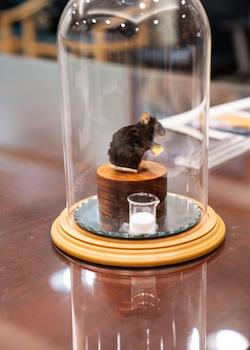Nearly 25 years after her birth made international headlines, Cumulina, the first cloned mouse and the first cloned mammal in the United States recently made the trek to her new home in the renowned Smithsonian’s National Museum of American History in Washington, D.C.

The most celebrated mouse in scientific history was named for the cumulus cells whose nuclei were used to clone her. Cumulina was created in a lab in 1997 using the distinctive “Honolulu Technique” developed by an international team led by Ryuzo Yanagimachi at the UH Mānoa John A. Burns School of Medicine. Yanagimachi’s work helped lay the groundwork for in vitro fertilization in the early 1960s. Although Yanagimachi officially retired in 2005, he continues to be an active researcher at UH Mānoa Institute for Biogenesis Research (IBR), which he founded.
“I view Cumulina as being an ambassador to the world for the biomedical research that’s done at the University of Hawaiʻi. The University of Hawaiʻi is a world-class Research 1 university. The discovery that a mouse could be cloned over and over again happened here before it happened anywhere else in the world,” said W. Steven Ward, director of the IBR and JABSOM professor.
Cumulina lived to a ripe age of 31 months, equivalent to age 95 in human years. She died of natural causes in 2001 and until she was donated to the museum, had been kept at the UH IBR, part of JABSOM.

“The fact that the Smithsonian Institute so eagerly accepted this gift is confirmation of the place in history that the discovery has. We are thrilled that the University of Hawaiʻi will now be recognized in the nation’s flagship history museum as having made a major discovery in biomedical science,” said Ward.
Along with Cumulina, the museum also acquired a sheet of paper streaked with the mouse’s footprints, made on her second birthday, which speaks to the research team’s excitement about the mouse’s normal aging process.
“Cumulina is a wonderful addition to our collection,” said Curator Kristen Frederick-Frost. “This tiny mouse will help our audiences explore complex topics, from the science of making copies of organisms to the ethics of doing so. When Cumulina was born, people wondered what, or who, was next. We still wonder. She is a part of the past that pushes us to consider the possibilities of the future.”
Smithsonian magazine spotlight

Like a celebrity, Cumulina was greeted in her new hometown with a special photoshoot courtesy of Smithsonian magazine. She’ll be featured in the National Treasure column in the June 2022 issue of Smithsonian Magazine. In D.C., she will be preserved in the museum’s Medicine and Science Division.
“I’m happy that more people can see her than here at IBR… It’s very good for us and for Cumulina too,” said Yanagimachi.
While the museum is exploring future display opportunities, details about Cumulina will be available on the museum’s website and in the American Treasures column of the Smithsonian Magazine. Cumulina was the first mammal to be cloned more than once and for several generations. In fact, the Yanagimachi Laboratory produced more than 50 carbon-copy mice using what was thought to be a more reliable cloning technique than the one used to create Dolly the Sheep. The clear reproducibility of the Honolulu Technique for cloning mammals convinced the world that cloning was real.
View photos of Cumulina on her way to Washington, D.C.
This work is an example of UH Mānoa’s goal of Excellence in Research: Advancing the Research and Creative Work Enterprise (PDF), one of four goals identified in the 2015–25 Strategic Plan (PDF), updated in December 2020.

